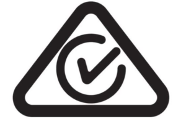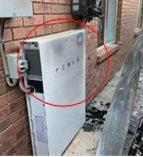Battery and Charging Safety
Many of today’s portable devices contain rechargeable lithium-ion batteries, which are light-weight, energy dense and long lasting. Devices such as phones, tablets, power banks, computers, toys, appliances, and tools, as well as mobility equipment such as electric bikes and scooters, are certainly convenient and make our lives easier. Unfortunately, ACT Fire & Rescue (ACTF&R) has seen a rise in fires related to lithium-ion batteries. It is important that we all understand the risks and be prepared if things go wrong.
How to identify a lithium-ion battery
Lithium-ion batteries (LiB) come in various formats (i.e. cylindrical, flat, rectangular, pouch, and device specific) and can be difficult to identify as there is currently no requirement or standard for labelling. Most Lithium-ion batteries will have some form of printing on them which contains either the words “lithium ion”, “Li-ion”, “Li-po”, “Lithium-polymer”, or some other variation of “Li” to denote the chemistry. If the battery is rechargeable and has “Li” or “Lithium” printed on it, you can safely assume that it is a lithium-ion battery.
Non-rechargeable or disposable lithium batteries, or lithium metal batteries should also be treated with caution as they can expel molten flammable metal and emit toxic gasses during a fire. Small fires involving single use, disposable lithium batteries should be treated as a Lithium-ion battery fire. Where large amounts of lithium metal batteries are used or stored, specialist Class D dry powder extinguishers may be required.
Why do lithium-ion batteries catch fire?
Lithium-ion batteries are energy-dense and contain electrolytes that are highly flammable. There are several situations that can lead to lithium-ion batteries catching fire, including:
- Overcharging or use of non-compliant charging equipment.
- Overheating or exposure to heat or extreme temperatures.
- Physical abuse (e.g. dropping, crushing, piercing, and/or vibrations).
- Short-circuiting, battery cell malfunctions or system faults.
- Defects or contamination introduced during manufacture.
When lithium-ion batteries fail they can undergo thermal runaway. This involves violent bursting of one or multiple battery cells, hissing and release of toxic, flammable, and explosive gases, and an intense, self-sustaining fire that can be difficult to extinguish.
E-Bikes, E-Scooters and other Light Electric Vehicles
Electric bicycles, electric scooters, electric mobility scooters, and self-balancing scooters, known as light electric vehicles (LEV), are growing in popularity.
LEVs commonly contain lithium-ion batteries and come with associated risks and hazards including fire and explosion, radiation, heat, chemical and electrical.
There are measures you can take to minimise hazards and risk:
- Only purchase and use devices and equipment from reputable manufacturers and suppliers.
- Only use chargers that are supplied with the device, or certified third-party charging equipment that is compatible with the battery specifications. Using chargers with incorrect power delivery (voltage and current) can cause damage to the battery including overheating that can lead to fires.
- Check that chargers bear the Regulatory Compliance Mark, to show that they meet the relevant Australian Standards under the Electrical Equipment Safety System (EESS).

- Avoid leaving LEV batteries or devices unattended while being charged or charging overnight. Once the indicator shows that a device or battery has been fully charged, disconnect it from the charger.
- Don’t charge or store LEV batteries or devices on combustible or insulating surfaces such as beds, sofas, or carpet, and keep them away from highly flammable materials such as blankets, clothing, and paper.
- Where possible, LEVs should be stored and charged outside in a garage, shed or carport away from living spaces. Keep them away from any exit doors, escape routes, and other combustible materials.
- Only have device repairs and battery replacements or upgrades performed by a qualified professional.
- ACT Fire & Rescue recommends that a smoke alarm or a heat alarm is installed in garages where a LEV is stored and/or charged. We recommend having a licenced electrician install and interconnect mains-powered smoke alarms where possible. Check with the manufacturer or distributor to ensure smoke alarm models are compatible for interconnection.
- Never store or leave LEV batteries or devices in areas where they can be exposed to heat or moisture. Do not leave devices in direct sunlight or in parked vehicles where they can quickly heat up.
- Don’t use LEV batteries or devices that show signs of swelling or bulging, leaking, overheating, or signs of mechanical damage (cracked, dented, punctured, or crushed).
Thermal runaway events involving batteries can occur rapidly and can often be quite violent, involving toxic smoke and vapours, flames, and metal projectiles.
Warning signs to look out for in a device or battery include:
- Pungent odours.
- Discolouration, blistering, bulging, or swelling of the casing.
- Leaking electrolyte.
- Heating up and feeling extremely hot to touch.
- Abnormal popping, hissing or crackling sounds.
- Smoke and fumes.
Never touch a swollen or ruptured device or battery with bare hands as the heat and/or chemicals can cause severe burns.
If the device or battery starts to smoke, emit vapours, or emit flames:
- Evacuate the area and close doors if safe to do so to slow the spread of fire and ensure no one goes back inside the building for any reason. The vented battery gases, vapour and smoke are highly toxic and flammable and must not be inhaled.
- Call Triple Zero (000) and wait in a safe location for firefighters to arrive.
- If anyone has been exposed to spilled electrolyte, flying debris, smoke, vapours, or flames, seek urgent medical assistance. Burns should be immediately treated with cool running water for 20 minutes. Burns larger than a 20-cent piece require emergency care. Treat with cool running water immediately, call Triple Zero (000), and follow the advice of the operator.
We don’t recommend handling anything that is on fire. If a small battery or device such as a phone or tablet starts overheating:
- Unplug it from the power outlet if it is on charge.
- Avoid inhaling any smoke, fumes, or vapours.
- If safe to do so, remove it to an outside area away from any combustible material and away from windows or doorways.
- If safe to do so, small devices can be dropped into a bucket of clean water to cool.
- Small flames can be doused with a bucket of water or a garden hose to stop the fire spreading to nearby objects. Make sure the device is not plugged in to mains power or near other powered equipment when applying water.
- If trained to use a nearby fire blanket or a fire extinguisher (dry chemical powder or carbon dioxide), only attempt to use them from a safe distance away from any smoke or vapours. These may be used to prevent the spread of fire to the surroundings but are not likely to fully extinguish a lithium-ion battery fire.
- Call Triple Zero (000) even if you no longer see visible smoke or flames. There is a good chance that the battery might reignite if it has not been sufficiently cooled.
Batteries that have been damaged can be involved in a second fire days, weeks or even month after the initial incident.
Batteries that show signs of damage including swelling or bulging, leaking, cracks, dents, punctures, or crushing should be disposed of carefully as described below. Never throw them in your regular waste or recycling collection bins. Fires can occur if they are crushed – e.g., in garbage trucks and recycling centres.
Batteries that have been impacted by water or liquid can also be extremely dangerous and should be treated as damaged.
Never charge a damaged battery.
What are my obligations if ACTF&R has attended a battery fire where I am the owner, occupier, or person in control of the site?
It is then the owner, occupier, or person in control of the site’s responsibility to ensure the following hazards are not present, safety precautions are put in place and to utilise correct battery disposal practices.
Direct and alternating electrical current, stranded energy and energised conductive materials pose the risk of electric shock.
Secondary ignition, fire and projectiles from batteries have the risk of physical injury.
Hazardous materials, toxic and flammable vapours released pose the risk of physical injury if inhaled, exposed to skin, or ingested.
Use caution moving or handling damaged batteries or equipment. If available, wear personal protective clothing. Store outside 3 to 15 metres from other structures, vehicles, or flammable material. Small batteries or devices can be placed and cooled in a container of water.
What should I do if my battery, battery powered device or electric vehicle (EV) is damaged?
ACTF&R advises in all circumstances that the manufacturer or a suitably qualified technician is consulted for additional advice before reuse or disposal of battery powered devices or EVs.
Damaged small household and handheld devices
Damaged batteries and battery-powered devices are classified as e-waste and should not be disposed of in general waste, bulk waste pickup, or waste heading for landfill as this poses a significant fire risk. If safe to do so:
|
 |
|
|
|
Damaged residential batteries
Damaged residential battery units must not be put back into operation, even if they appear undamaged on the outside. If safe to do so:
|
 |
|
|
|
Damaged EVs
An EV that has been involved in a serious collision, or has been impacted by water or fire, has a higher risk of experiencing a battery short circuit, which may result in a fire. If safe to do so:
|
 |
|
|
|
Environmental
Batteries often contain combustible materials and heavy metals, which are known to be environmental pollutants. When damaged, a battery contents can negatively impact the environment. Correct disposal of damaged and undamaged batteries is important to the safety of our environment.
There are things that you can do to prevent an incident involving lithium-ion batteries:
- Only purchase and use devices and equipment from reputable manufacturers and suppliers.
- Only use chargers that are supplied with the equipment or device, or certified third-party charging equipment that is compatible with the battery specifications. Using chargers with incorrect power delivery (voltage and current) can cause damage to the battery including overheating that can lead to fires.
- Check that chargers bear the Regulatory Compliance Mark, to show that it has met the relevant Australian Standards under the Electrical Equipment Safety System (EESS).
- Avoid leaving batteries or devices unattended while being charged or charging overnight. Once the indicator shows that a device or battery has been fully charged, disconnect it from the charger.
- Don’t charge batteries or devices on combustible and insulating surfaces such as beds, sofas or carpet, and keep them away from highly flammable materials such as blankets, clothing, and paper.
- Never use and charge devices such as phones, tablets and e-cigarettes or vaping devices in bed, where they can overheat if you fall asleep.
- Larger batteries and equipment such as power tools and electric scooters should be charged in the garage, shed or carport away from living spaces.
- ACTF&R recommends ensuring that a smoke alarm or a heat alarm (where a smoke alarm cannot be installed) is installed in areas where devices are often charged. We recommend having a licenced electrician install and interconnect mains-powered smoke alarms where possible. Check with the manufacturer or distributor to ensure device models are compatible for interconnection.
- Never store or leave batteries and devices in areas where they can be exposed to heat or moisture. Do not leave devices such as phones, computers or charging devices in direct sunlight or in parked vehicles where they can quickly heat up.
- Don’t use batteries or devices that show signs of swelling or bulging, leaking, overheating, or signs of mechanical damage (cracked, dented, punctured, or crushed).




